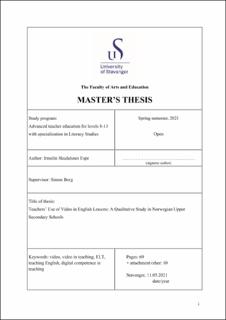| dc.description.abstract | Technology has become an increasingly central feature of education and in Norway teachers are expected to integrate technology into the way they teach. This study focuses on the use of video by teachers of English in upper secondary schools in Norway. Specifically, the aim of the thesis is to explore how teachers choose and use video in English lessons and the factors, such as teachers’ beliefs and the curriculum, that influence their decisions. The two research questions that are addressed are: What are teachers’ beliefs about the value of videos in learning English? What process do teachers go through when finding and implementing videos for English lessons?
The data in the study was obtained through a qualitative method. Four teacher participants from two upper secondary schools in Norway took part in semi-structured interviews. The first interview explored the teachers’ general experiences of and attitudes to technology and technology in teaching, while the second interview focused more on their use of video in lessons. To support the discussion of their teaching, teachers were asked to provide an example of a lesson plan where video was used and this was referred to in the interview.
The study found that teachers see great value in using and implementing video in teaching English. Specifically, the teachers see video as valuable because it enriches the lessons and brings an extra dimension into teaching. For the purpose of using video, it was found that video was mostly used to teach content and gain cultural insight. The use of video for such purposes seemed to be highly influenced by the English subject curriculum. A further value seen by the teachers was how video could explain topics more precisely than the teachers themselves were able to. Additionally, this resulted in video functioning as a timesaving factor for the teachers.
As the teachers were mainly focused on teaching content and culture, one interesting finding was that there was not much explicit focus in teachers’ work on how video supports language development. However, the study found that the focus on language was not entirely absent. Video was used as explainers to teach linguistic skills such as learning how to write paragraphs.
Video appeared to be well-considered before being implemented in the English teaching, and this was seen in several criteria proposed by the teachers for finding, choosing and implementing videos. Especially prominent criteria were the use of reliable sources, using video with a specific purpose, connecting videos to the curriculum competence aims and using videos with beneficial length in accordance with the purpose of the video. The criteria were reflected in what videos the teachers chose.
How video was used in the classroom varied between the teacher participants. Still, it was seen that using activities linked to video was important to all four. While the main focus was on pre-teaching activities, some of the teachers saw value in using post-viewing activities as well. It was seen that it was important for the teachers to provide the students with a main aim so that they knew what to look for when watching a video. The activities were thus connected to the purpose of the video.
All four teachers reported using video regularly in their teaching. The extensive use of video by the teachers can be linked to their digital competence and positive feelings connected to the use of technology. The teachers saw great value in including video in their teaching. Some stress was linked to the use of technology in areas the teachers were not familiar with, but generally very little negative feelings were associated with the use of video. The teachers’ beliefs about using video were thus positive and could be seen as a reason to why video was heavily implemented in their teaching. In light of this it appeared that the teachers’ digital competence met the criteria presented for teachers in the Norwegian framework Professional Digital Competence Framework for Teachers (Kelentrić, Helland, & Arstorp, 2017). In one of the seven areas of the framework, pedagogy and subject didactics, it is specified that teachers should implement digital resources in teaching to foster students’ learning and development. It was found that the teachers in the study did just this. Further it was seen that the focus on content and culture was linked to the teachers’ responsibility to focus on danning (cultural formation/self-cultivation) mentioned in the Core Curriculum (2017).
The thesis sheds light on how teachers choose and use video in English lessons and also provides insight into the factors that influence their pedagogical decisions regarding the use of video. By focusing on the teachers’ beliefs about the value of using video, useful insights into the process of planning and implementing video were seen in the study. Lastly, the study raised some interesting questions on the limited language focus found in relation to video use in the ELT classroom. | |
